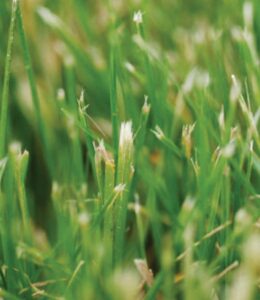|
|

Turf that was cut with a dull blade. (Photo courtesy Purdue University Turf Department’s Aaron Patton)
Most people do not put a lot of thought into mowing a lawn. You fire up the engine, go to your traditional starting point, then traverse the lawn until the machine has covered every square foot. Then, it goes back to the barn or garage to wait until the next opportunity.
We should think of mowing as being more complex than we do. The overall health of our turf is very dependent on how we mow. Here are a few ideas on mowing for your consideration.
First: Mowing Height
Many people mow way too low. For our traditional bluegrass, perennial ryegrass or fescue lawns, the mowing height should be no less than 3 inches. Mowing lower than 3 inches allows weeds to flourish, because weeds can handle that stress better than grass. I have a large lawn, with no irrigation and a minimal amount of fertilizer, and I honestly think mowing high is the best way to help my turf be healthy and denser.
To measure how high you are mowing, just pull the mower onto a flat surface and measure the distance between the surface and the lowest point on the cutting blade. If that measure is less than 3 inches, move the stops to raise the deck up.
Second: Mowing frequency
A lot of people mow when it is convenient for them, not for the health of the grass. If you are a “Saturday or Sunday afternoon” mower, you know what I mean.
The best practice is to mow when the grass is ready, removing no more than 1/3 third of the blade. If mowed at 3 inches in height, a bluegrass lawn would then be mowed at a maximum height of just over 4 inches. If you wait until the lawn is 5-6 inches tall, there is a shock that occurs within the plant, depleting some of root food reserves.
That means mowing more frequently, based on the plant needs, and not based on the day of the week. Certain times of the year, like in mid-May, when turf seems to grow like crazy, you may need to mow every 3-4 days instead of once a week.
Third: Pick up the clippings?
There is always debate of picking up clippings or blowing them back into the lawn. If you mow more frequently, there will be little issue with the build up of too many clippings. If you find yourself blowing large clumps of clippings back onto the lawn, you are not mowing frequently enough. Sure, there are times when its going to get away from you, like when it rains every day or you go on vacation. Picking up the clippings is probably necessary at that point. More frequent mowing will recycle the nutrients in those clippings, and reduce the chance you will have clumps of clippings scattered across the lawn. Clippings do not contribute to thatch, but can mat down a lawn.
Fourth: Change up the pattern
Following the same pattern can create lanes where soil becomes compacted. Even push mowers can create tire compaction. As a new homeowner, I saw a 1-inch-wide rut develop 22 inches from the foundation and landscape timbers where the tires would roll every mowing. By using a string trimmer and changing up the distance I mowed from the obstacles, I eventually broke the pattern up.
Finally: Sharpen the blades!
Most people do not sharpen their blades enough. If the end of the cut grass blades looks frazzled instead of smoothly cut, it’s time to sharpen the blades. Lawns with tall fescue, in particular, take on a grungy appearance when mowed with dull blades, because their leaf blades have coarse veins that shred in a manner similar to celery. Seedheads, with their fibrous stems, can dull a mower blade very quickly, much faster than grass blades themselves.
There are health benefits for your turf from mowing with sharp blades. The grass will heal faster, lose less water from the cuts, and resume photosynthesis faster.
Professionals typically sharpen blades after only 10-15 hours of mowing! That’s way more frequent than most homeowners do, including me! I have learned to keep an extra set of blades on hand to make the task easier.
Jeff Burbrink is the agriculture and natural resources extension educator for LaGrange County Purdue Extension. Contact him at 499-6334 or jburbrink@purdue.edu.



Leave a Reply